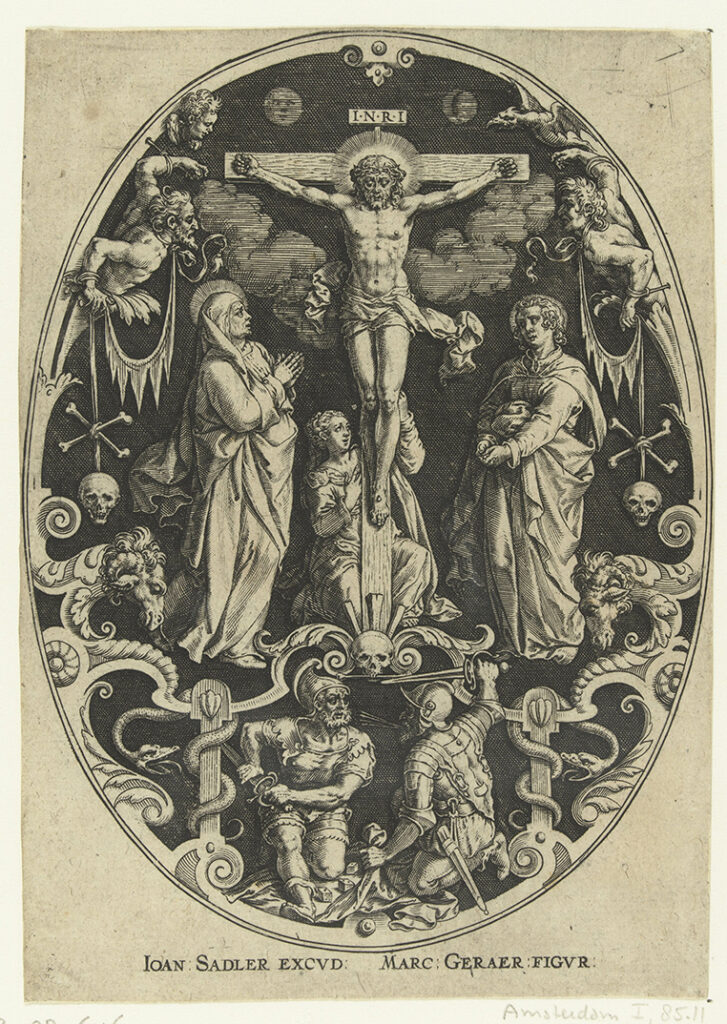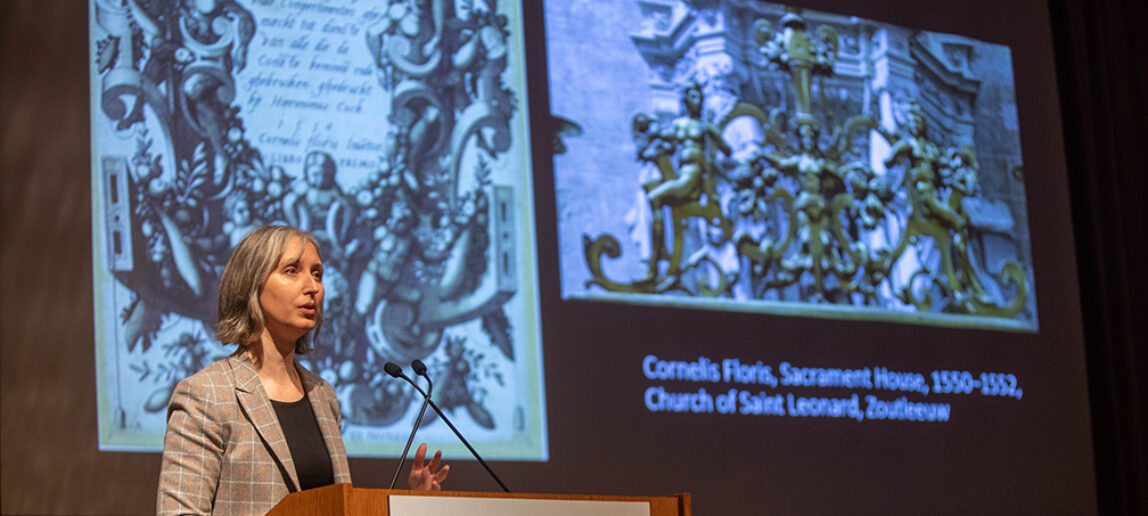Research Spotlight: Dr. Tianna Uchacz Studying Ornament Print Title Pages Through Arts And Humanities Fellowship
A moment of discovery for Dr. Tianna Uchacz in her graduate student days led to a longtime interest and research focus.
Uchacz, assistant professor of art history and craft technology in the Visualization program, was researching Netherlandish artists in the print collections of the New York Public Library when she encountered an ornament print series by Marcus Gheeraerts. The half-ornament, half-Passion prints caught Uchacz’s eye because the ornament design grew into the narrative of the Passion.

“Think about a typical crucifixion scene, with Christ and the two thieves being crucified on either side of him,” she said. “Here, they’re not set on Golgotha with throngs of mourners and Romans beneath the crosses. Instead, you’ve got Christ on the cross and the two thieves growing out of floral ornament on the side.”
The series also had a title page, which made claims about what kinds of artists would find these ornament prints most useful.
“And I thought, ‘This is so weird,’” she recalled. “And then I started looking more carefully and realized this title page is not the only one. There’s a whole subset of title pages like this. They’re not just in print series. They’re also in embroidery books, introducing designs for embroidery. Which make sense because books have title pages, and they also make claims like this. In other words, the ornament print title pages belong to an emergent genre that’s riffing on other established conventions in printing.”
Uchacz is in the midst of a three-year Arts and Humanities fellowship from the Division of Research that includes $15,000 for her work examining these title pages. Dr. Dawna Schuld, an associate professor in the Visualization program, also received the research fellowship.
Ornament prints are often tied to art and industry, Uchacz said. An example: burin-engraved ornaments that were used to embellish plate armor for knights.
“The idea was if you figured out a really nice pattern as an armorer, you could rub some ink in the grooves of the design and then rub a paper over it and pull away a print of the design, and then you’d have a record of that pattern to use again in the future,” Uchacz said.
Artists began to design ornament to be shared by print, independent of any actual use on objects. When the prints began to be bundled into a series of pages in the mid-16th century, interest expanded from artists to include collectors. The series began to include title pages that made claims that the prints and designs were useful for a variety of artists, and specifically named them, like architects, embroiderers, and goldsmiths, Uchacz said.
“How could one series of designs be useful to all of them?” Uchacz said. “I mean ‘how’ in a very practical way. What would you have to do to take this 2D design for ornament and translate it into an architectural frieze? Or into the filigree embellishment of a gold chalice? Or into an embroidered scene?”
Uchacz’s research tackles assembling the corpus of these title pages, and examining the languages, locations, range of artists and rhetorical flourishes of the claims. She and her team of student workers are creating a digital repository, so they can filter the title pages by artist category or claims of utility.
The second part of the project is collaborating with artists familiar with historical tools and techniques to translate the ornament from a 2D design into actual form, like jewelry, hammered silver, carved wood or a painting. Uchacz will note how the artists make decisions and fill in intermediary steps that the print doesn’t explicitly define.
“When these title pages claim utility, what does it mean for them to be useful?” she said. “Are these supposed to be pattern books or jumping off points for more imaginative designs? If you’re a wood sculptor and you’ve got to translate this pattern into oak, how do you translate the dimensionality of the design? What’s the horizon of possibility in terms of translating the 2D into 3D?
“Those are the kinds of questions I am not now equipped to work on myself because I don’t have the hand skills to be able to answer them through art making myself. That’s why partnering with artists is so important. They stand in as a proxy for the Renaissance artist to help me get a better sense of what was possible with these prints.”
In addition to creating works based on the print template, the artists will make a second version based on their own interpretation, using the prints as “a springboard for their imagination,” with Uchacz again probing the decision-making process.
The grant allows commissioning the artists and purchasing materials, and the team is in the closing stages of the print database.
Uchacz said it’s useful to make historical arguments about prints and title page claims, noting that ornament prints rose in popularity after the 16th century.
“I want to take these claims seriously,” she said. “I think if we look at how and in what ways they could be useful, we are going to find some scholarly insights that we just didn’t have access to before, because we never thought to ask.”

